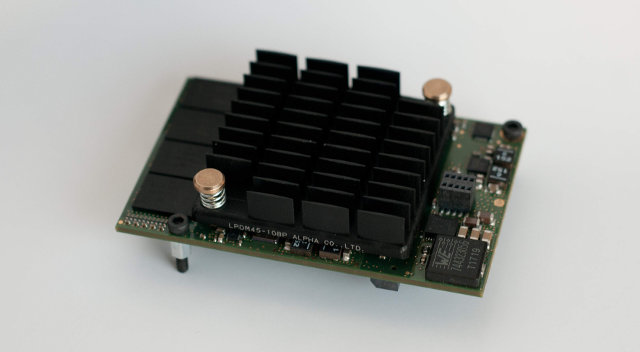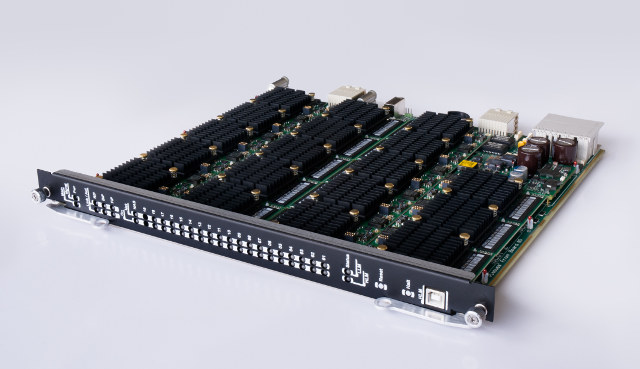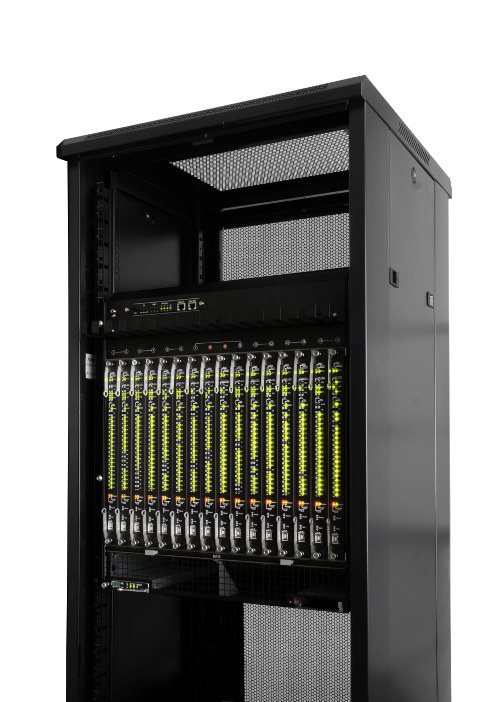Iliad (Free) is a French company known to bring the price of technology down for the masses. Several years ago, they disrupted the Internet broadband market, by bringing low cost triple play broadband services to market, and more recently they entered the mobile market with 2 Euros 3G/4G monthly subscriptions. The company also owns Online.net providing hosting services, and which has recently launched a public preview for Online Labs cloud platform. Most hosted solutions nowadays relies on x86 servers and virtualization, but Online Labs instead features dedicated physical ARM servers connected to SSDs.

The company call their custom-made credit-card size server modules C1 boards, completely unrelated to ODROID-C1 boards, as those are powered by a quad core ARMv7 Marvell processor with 2GB RAM, and a 1Gb/s network interfaces. These are then assembled into racks as shown below.
 And finally 16 racks are inserted into a chassis with a control board, and power supply. Based on the picture above and below, I count 288 C1 servers, but the company claims “912 servers per rack”,
And finally 16 racks are inserted into a chassis with a control board, and power supply. Based on the picture above and below, I count 288 C1 servers, but the company claims “912 servers per rack”,
That’s for the hardware. On the software front, a control panel offers options to create, snapshot, image and clone servers, and it takes two clicks to create a Linux server, and the system boot in about 30
seconds on SSDs. It also comes with on-demand storage, movable IPs and an S3 compatible object storage service.
A free 15-minute trial is available on labs.online.net, if you can access the service which is currently pretty busy. The trial server(s) run(s) Ubuntu Utopic 14.10 with docker pre-installed on a 20GB SSD. You can also “ask for an invite” to get a full preview.
I manage to get a free trial for 15-minutes, but instead of logging in the web browser, I logged in via SSH with is more convenient to copy/paste the terminal output.
I’ve run some command to get some more infor about the system:
|
1 2 3 4 5 6 7 8 9 10 11 12 13 14 15 16 17 18 19 20 21 22 23 24 25 26 27 28 29 30 31 32 33 34 35 36 37 38 39 40 |
ubuntu@c1-10-1-22-140:~$ cat /proc/cpuinfo processor : 0 model name : ARMv7 Processor rev 2 (v7l) Features : half thumb fastmult vfp edsp thumbee vfpv3 tls idiva idivt vfpd32 lpae CPU implementer : 0x56 CPU architecture: 7 CPU variant : 0x2 CPU part : 0x584 CPU revision : 2 processor : 1 model name : ARMv7 Processor rev 2 (v7l) Features : half thumb fastmult vfp edsp thumbee vfpv3 tls idiva idivt vfpd32 lpae CPU implementer : 0x56 CPU architecture: 7 CPU variant : 0x2 CPU part : 0x584 CPU revision : 2 processor : 2 model name : ARMv7 Processor rev 2 (v7l) Features : half thumb fastmult vfp edsp thumbee vfpv3 tls idiva idivt vfpd32 lpae CPU implementer : 0x56 CPU architecture: 7 CPU variant : 0x2 CPU part : 0x584 CPU revision : 2 processor : 3 model name : ARMv7 Processor rev 2 (v7l) Features : half thumb fastmult vfp edsp thumbee vfpv3 tls idiva idivt vfpd32 lpae CPU implementer : 0x56 CPU architecture: 7 CPU variant : 0x2 CPU part : 0x584 CPU revision : 2 Hardware : Marvell Armada 370/XP (Device Tree) Revision : 0000 Serial : 0000000000000000 |
The exact Marvell processor is Armada 370/XP running a recent Linux 3.17.
|
1 2 |
ubuntu@c1-10-1-22-140:~$ uname -a Linux c1-10-1-22-140 3.17.0-90 #7 SMP Mon Oct 20 13:54:37 CEST 2014 armv7l armv7l armv7l GNU/Linux |
Let’s also check storage and RAM:
|
1 2 3 4 5 6 7 8 9 10 11 12 13 14 |
ubuntu@c1-10-1-22-140:~$ df -h Filesystem Size Used Avail Use% Mounted on /dev/nbd0 19G 817M 17G 5% / none 4.0K 0 4.0K 0% /sys/fs/cgroup none 1009M 4.0K 1009M 1% /dev none 203M 104K 202M 1% /run none 5.0M 0 5.0M 0% /run/lock none 1011M 0 1011M 0% /run/shm none 100M 0 100M 0% /run/user ubuntu@c1-10-1-22-140:~$ free -mh total used free shared buffers cached Mem: 2.0G 470M 1.5G 112K 38M 364M -/+ buffers/cache: 68M 1.9G Swap: 0B 0B 0B |
20 SSD and 2GB RAM as advertized.
Here’s the Linux kernel boot log for those who want to known more details without trying.
Finally, I’ve tested the network performance with speedtest command line:
|
1 2 3 4 5 6 7 8 9 10 11 12 13 |
sudo apt-get install git git clone https://github.com/sivel/speedtest-cli.git cd speedtest-cli/ ./speedtest_cli.py Retrieving speedtest.net configuration... Retrieving speedtest.net server list... Testing from Tiscali France (212.47.230.57)... Selecting best server based on latency... Hosted by FreeMobile (Paris) [1.59 km]: 4.806 ms Testing download speed........................................ Download: 312.28 Mbits/s Testing upload speed.................................................. Upload: 140.75 Mbits/s |
I could only wish I had that kind of broadband speed at home…
Pricing and broad availability have not been announced, but I understand they may follow an hourly pricing, similar to what Digital Ocean offers based on an article on Venture Beat.
Thanks to Benjamin for the tip.

Jean-Luc started CNX Software in 2010 as a part-time endeavor, before quitting his job as a software engineering manager, and starting to write daily news, and reviews full time later in 2011.
Support CNX Software! Donate via cryptocurrencies, become a Patron on Patreon, or purchase goods on Amazon or Aliexpress





Not sure I really the point vs cheap virtualized servers that are much more easily tailored to the hardware requirements you have…
/dev/nbd0 means a Network Block Device, so the disk is mounted through a SAN maybe?
Some disk write test:
root@c1-10-1-21-11:~# time dd if=/dev/zero of=1G bs=1M count=1000
1000+0 records in
1000+0 records out
1048576000 bytes (1.0 GB) copied, 13.3852 s, 78.3 MB/s
real 0m13.391s
user 0m0.030s
sys 0m10.160s
If that is a standard 42U rack, and that “module” supports 288 of these I could see a full rack with at least 912. Although that would be 3.16 of these modules, which doesn’t make sense unless there is a different sized module that only has 48 of them.
Are they going to sell that “module”? Or did they just have them built so they could resell VPS?
After cpuinfo : vfpv3 <= so that's second generation Cortex A (Cortex-A5 or A9). the cheap odroid use A5, this could also be A9, so not fast as recent one (with a7 and/or A15 or rockchip a17).
So that's not the more efficient today, but could be far cheaper for a first test, the SoC daughterboard could be changed later…
@Popolon
They also needed an SoC with Gigabit Ethernet and SATA, the latter requirement seriously narrowing the field.
Hello Jean-Luc, I have an invite an play well with about 10 C1-server since many weeks now ( i test a ceph cluster ). When you build your C1 server (in the web control panel when you have an invite), you can choose the linux distribution ( debian wheezy, gentoo, ubuntu utopic, ubuntu trusty, fedora 20 beta), the storage SSD and/or HDD (you can add many storage volume to 1 server). Some of C1 of the board are not accessible and dédicated to manage the storage (a SAN like). You can choose what kernel to use for your C1 with… Read more »
@Popolon Actually the Armada XP used by Iliad/Online is not a Cortex-A processor. Marvell has an architecture license from ARM, and the Armada XP use a PJ4B-MP core, which implements the ARMv7 instruction set, but isn’t a Cortex-A from ARM. Marvell now has some more recent chips (the Armada 375 and Armada 38x) that are Cortex-A9 based.
They plan to sell their C1 board soon with 4x Gigabit Ethernet, mSATA, and mini PCIe -> https://twitter.com/imoins/status/560459753152086016
I wonder what advantages this might have over VPSs – which also seem pretty cheap these days? (eg see http://lowendbox.com/)